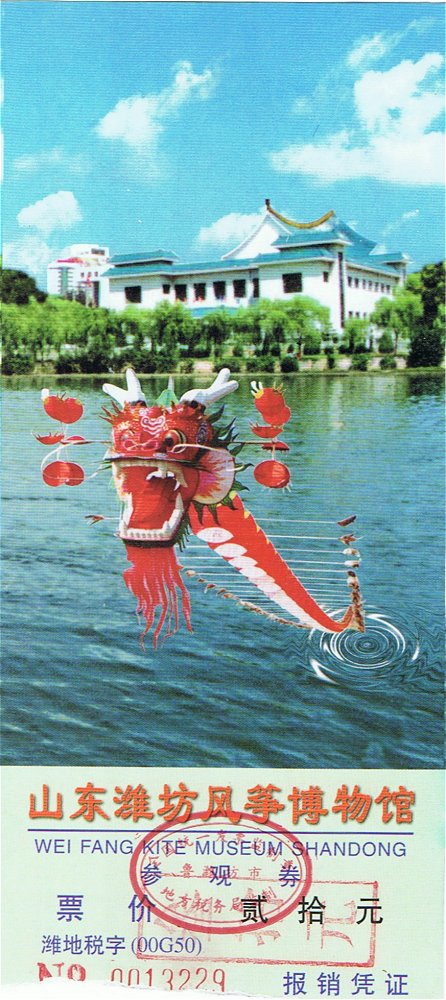The History of Chinese Kites
with Respect to WeiFang, the Capital City of Kites
- All texts are largely adapted to the Chinese original in language and style to illustrate the differences to Western kite flying.
WeiFang is a modern city with many traditions. The city has about a million inhabitants, and is situated in ShanDong, the most easterly province of China. WeiFang is known from anciant times, and has a rich history and culture of more than 1000 years. Kites from WeiFang are amongst the best ones in China.
During the Spring-and-Autumn-Period and the period of the Warrying-Empires (475-221 v.u.Z), some 2300 years ago, the first kite had been developed in the province of Shandong. The long literary tradition of China enables us to find more detailed information. Regarding to the book of Han Fei Zi, the master of joinery 'Mu Zi' (墨子, MoZi) had been contructing within three years time of developement a man-lifting kite, known as the Wooden-Black-Eared-Kite. The book of 'Hong Shu' tells us, that some time later the master of joinery named Lu Ban, had been building another Wooden-Black-Eared-Kite, that had been used as reconaissance device over the sky of the ancient city of SongCheng. Both masters originate from the ancient state of Lu, today named QuFu. QuFu is known as the birthplace of Confucius (551-479 b.c.). The city of Qufu has historic grounds of outstanding historical interest, especially the imperial palace of the Confucius family, the grove and parque with the grave of Confucius, and the extent living quarters of the dukes of the Confucius descendants.
Lu Ban's work is relatively well described. There are many classic books that mention him to be the sole inventor of the kiten. Literature about MoZi is rather sparse. Therefore, mostly Lu Ban is described in modern literature as the inventor of the kite. In addition, Lu Ban is the Daoist patron saint of various trades, and there are various Lu Ban shrines throughout Southeast Asia. A small selection can be found under the following link.
 |
When the feast of cold fare begins in the third moon Excusionists will roam the banks of the BaiLang river Boys flying kites and girls swingingin the air In springtime the grass is already very long And many swallows return |
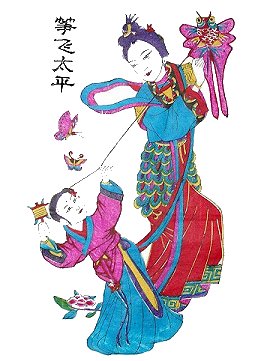 |
| Original
New Year's Picture from YANG LuoShu without Kite |
Springtime poem of Guo Lin (Qing Dynasty) | New Year's Picture from YANG LuoShu with Kite |
The first descriptions of kites made with bamboo frames covered by paper and silk, originate from the Tang Dynasty (618-907 o.o t.). Within his book of kites, Yang Cai writes not only about the classic Wooden-Black-Eared-Kite, but also about many other kinds, known and build up to date. Especially the heron or egret kite, a bird kite with wings and legs that are moving like real ones, gives a realistic view of flight. Todays quality kites sometimes are constructed according to these historic patterns mimicing a living birds when landing. Just have a look at the Hunting Eagle Kite with his realistic claws, threedimensional beak and inclined head. When landing this kite, it gives a realistic impression of an eagle preying on game.
Some kite builders started attaching bamboo stripes to kites. When the kites were high in the air, these bamboo stripes vibrated and soundup in the sky were reminiscent of a 'Zheng Zither' (a stringed instrument). Since then, this has been the most popular Chinese name for kites as flying objects. The term 'FengZheng' (wind 'Zheng' or wind zither) refers to this. Kites with sound-producing instruments can also be found in the kite exhibition on this website (cf. HuaShu or LingZhi with string instruments, and kites with calabash flutes).
Chinese names for 'kites'
- FengZheng (wind zither, 风筝)
- ZhiYuan (paper hawk or paper milan, 纸鸢)
- FeiYuan (flighing hawk or flighing milan, 飞 鸢)
- Further information on the word origin and history of names for 'kites' may be found in the notes for "Chinese names for kites"
WeiFang International Kite Festival
WeiFang belonged to the sphere of influence of the historical 'Warring States'. The city had already developed into the most important place of kite production in China during the Ming and Qing dynasties. The World's Largest International Kite Festival has been held in WeiFang every springtime since 1984. In 1988 Weifang was declared the Kite Capital of the World. The following year the World Kite Federation (International Kite Federation, IKF) was founded. The kite festival always takes place on the third weekend in April. In 2020 it was canceled due to the corona pandemic.
The
first festivals beginning from
1984 into the 1990s took place in the urban
area. From 2000 until
2015 it took place in FuYanShan from 2000 to
2015. Nowadays the festival , is held in the BinHai
Resort. BinHai (滨海, literally: coast on the sea)
is located directly on the BoHai sea, the
adjacent gulf north of the ShanDong Peninsula. BoHai
has large
beaches and large open spaces. In the meantime,
a new
kite sport field has been opened. directly
situated on the coast line. The vast open spaces are
ideal for the Largest Kite Festival in the World,
particularly with regard to the presented kites
becoming larger and larger, a tendency to be
noticed at large kite festivals in general. Most of
these big ones are inflatable
kites. They are in growing numbers conquering
the sky above the airfields. This is quite
understandable, since the public often has to watch
from a far distance for safety reasons, but the
audience should also be shown something spectacular.
BinHai has a kite surfing center for international
competitions located directly on the beach. Kite
surfing has also become an established Olympic
sport. Many other interesting details can be found on
the separate Kite Festival
web page.
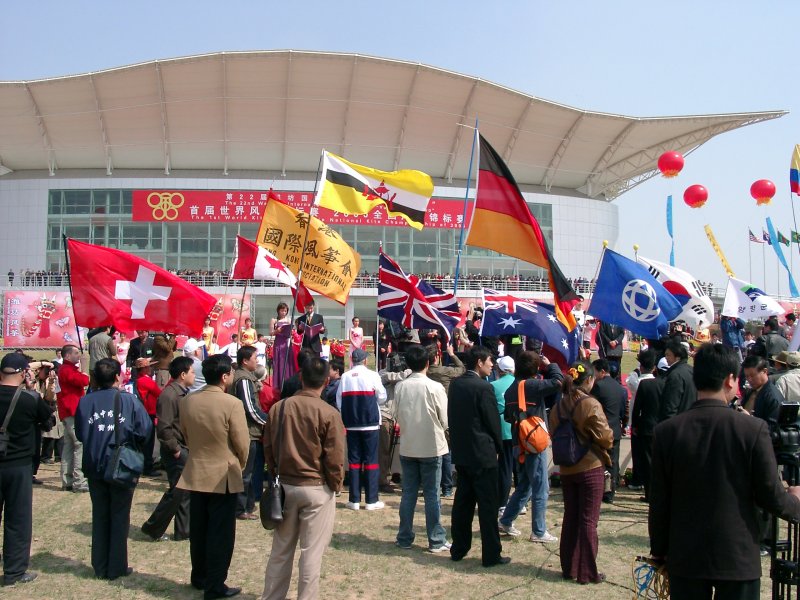 |
 |
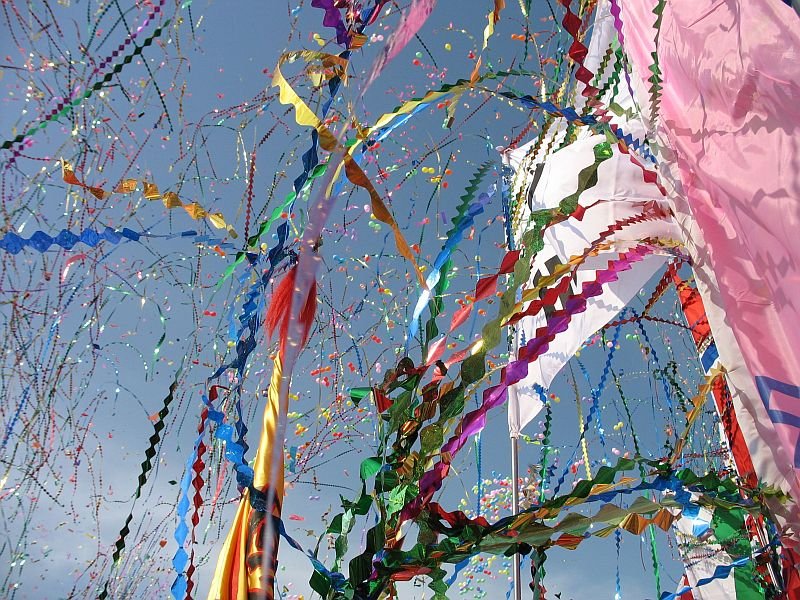 |
| Opening Ceremony
(FuYanShan, 浮烟山) |
WeiFang
International Kite Festival (FuYanShan, 浮烟山) |
Opening Ceremony,
Confetti salute (FuYanShan, 浮烟山) |
Museums and other kite-related institutions
Weifang Kite Museum
The "history, beauty and diversity of kites from all over the world" is evocatively illustrated in the peerless Kite Museum of the city of WeiFang. Seen from afar, the roof shape of the building is reminiscent of a centipede. You are cordially invited to enjoy the history of kites, which spans more than 2,300 years. The spacious building has a large inner courtyard, it has two stories, each story with two wings, and each wing with two large exhibition rooms. All explanations about the kites are bilingual (Chinese / English). You will find technical information about kites and kiting, about other kinds of kite related special features, and about unusual kites and kite items. Even a selection of the largest kite stamp collection in the world is to be seen, but without reference to the origin. The underlying poster was handed over to the then mayor in 2003. Furthermore, the museum houses rooms for kite building resident artists who also work on site. You will also find a well-stocked museum shop, an auditorium with a large cinema, a large room for workshops and much more.
In front of the museum is a larger-than-life LuBan sculpture, whith the legendary kite builder and inventor with his arms spread out by a stylized large bird kite. An allusion to the historically presumably first technically mature kite in the world.
WeiFang City Museum
In addition to the large WeiFang Kite Museum, there is also a remarkable kite collection in the Weifang City Museum. A cross-section of the locally produced kites is exhibited in a large showroom, and kites and kite production is embedded in the economic and historical context of the entire region. The exhibition on the history of the city and the district of WeiFang is worth seeing. The history is evocatively illustrated in small dioramas. Anyone who has seen the old city gate with the remains of the city wall on the river, may vividly show, what historic WeiFang might have looked like. There are excavation finds from past millennia, a picture gallery, traditional costumes and much more to discover. In addition to cultural aspects, a scientific collection is housed in another wing.
ShiHuYuan
ShiHuYuan (十 笏 园) was the former residence of a wealthy businessman with a beautiful, classically landscaped garden. ShiHuYuan invites you to linger and enjoy a historic park in WeiFang central. Interesting historical objects can be found in the many outbuildings. Art and culture give a vivid impression of the life of a privileged class of the past. Directly in front of the entrance to ShiHuYuan is a small street with several kite dealers, where it is worth to rummage. Since 2015, a cultural and exhibition area has grown here, which has integrated further historical structures and also invites you to visit.
World Kite Plaza
In the center of the city and directly next to the kite museum, is the city's vast World Kite Plaza (FengZheng GuangChang, 风筝广场), a park with many larger and smaller kite related sculptures that show WeiFang's role and position as the capital of the World of Kites. A long kite frieze showing the Chinese history of kites can be seen from the entrance near the city centre. The kite plaza shows many floor bas-reliefs. Many international kite organizations have these kinds of ornamental tablets at the Kite Plaza. A good overview of complete Kite Plaza is provided by the local escape and evacuation plan, which is mandatory in many Chinese parks and plazas.
On many streets of the city you may find street lanterns, which are decorated with the motif of a butterfly kite. They are even illuminated at night. The kite frame of a butterfly kite is the Chinese symbol for "kite" par excellence. Even taxis with this kite symbol may be found, and the International Kite Federation also has this kite symbol as a logo.Kite Dealers
In addition to their original production facilities in both of the kite building villages YangJiaBu and WangJiaZhuangZi, many kite dealers and kite manufacturers also have representative offices in the city area. In those shops and showrooms you may always find interesting old and new kite treasures while rummaging around. Usually you may also buy them. Relatively many kite shops can be found in HePing Street (和平 路, HePingLu). Since "HePing" ("Peace") is also my Chinese name, I am particularly pleased that there is a "HePing kite store" (和平 风筝, HePing FengZheng) on HePing Street.
WeiFang's kites have striking artistic peculiarities. The themes and forms of the kites are distinctive, unique and extremely versatile. For example, birds and other animals, flowers, fishes, butterflies and other insects, marine animals, but also topics from folk mythology and religion, folk tales, fairy tales and legends are presented. These themes are reflected in the painting, but also in the actual shape of the kite itself. "The Four Skills of Kite Building" are deepened on a separate page.
Chinese kites can be divided into four categories:
- Centipede or millipede kites (also called the scolopender kite forned after the Greek loan word)
- Hard wing kites
- Soft wing kites and
- Flat kites
Kite Builders Villages - Rich in Tradition
YangJiaBu Zhen
The kite builders village YangJiaBu (杨家 埠镇) is located about 15km northwest of the city center in the HanTing district (寒亭 区) of WeiFang. Like all rich communities, YangJiaBu has a large entrance gate. In addition to the many kite factories worth visiting and their corresponding showrooms, YangJiaBu has also a History Park. The Park is a kind of museum, and has more than 30 buildings with exhibitions and sales rooms, covering all kinds of subjects of traditional folk art. Music, dance performances, parades and other events also take place within its vast exhibition ground. It covers kite and culture fairs. The Park is styled like a historic medieval city with a traditional wall and gates.
In addition to traditional kite construction and building with all kinds of bamboo processing steps (see "The Four Craftsmanships of Kite Construction"), such as splitting, hot bending, joining and covering the frame, you may also learn more about the history of wood block prints and how to make them. Even a beautifully designed airfield with a classic walkway is on the site where customers may have their purchased kites flown-in by competent staff.
 |
 |
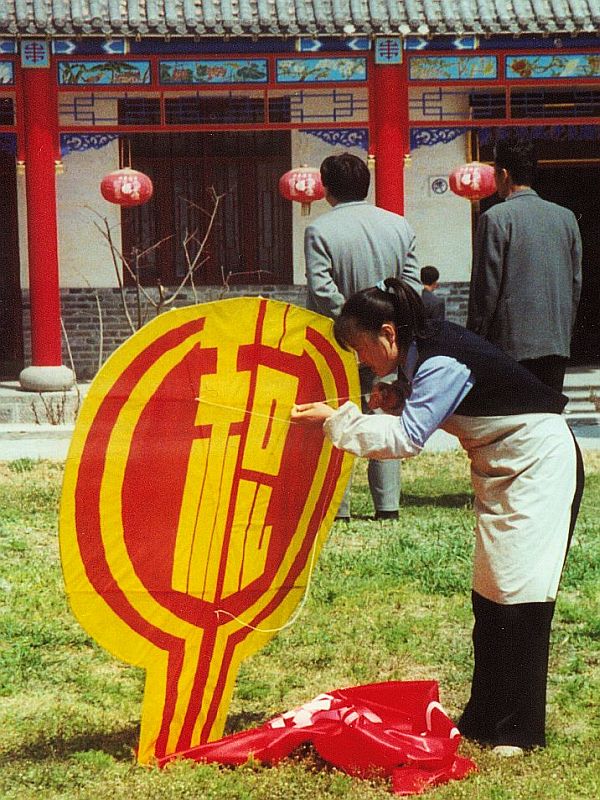 |
| Classic
ambulatory adjoining the kite field |
The testing airfield with staff flying the purchased kites | The kite with the character for "Customs" (税, Shui) was purchased by the customers in western suits (customs officials). The lady from the staff is fixing the new kite, prior to the fly-in |
WangJiaZhuangZiNew Year's Pictures
In addition to the kite-makers village YangJiaBu, there is another kite-makers village within the city boundaries of WeiFang, named WangJiaZhuangZi (王家 庄子). The hamlet claims to have started commercial kite building as the first village in the area. WangJiaZhuangZi is located about 15 km southwest of the city center in the FangZi district (坊子 区), and has an interesting and new museum of the local kite manufactory (TVE, 乡镇 企业), and is definitely worth seeing. The newly built Museum features History of Kites in general, and the History of the WeiFang Kite Festival in a complete picture series. On the first floor is a showroom with hand-made traditional kites, where occasionally kite builders show their refined art.
New Year's painting is part of a culture that is cultivated throughout China. Topics are mostly about auspicious New Year's customs. Starting in the course of the lunar New Year or "Spring Festival", Chinese front doors and entrancesare adorned with asupicious slogans and pictures, just to keep evil spirits away, and make sure, that te coming New Year will be a happy one. WeiFang was and is famous for these kinds of colorful pictures and drawings. WeiFang kite builder were the first ones to apply these colourful woodblock prints on kites. Applied to flying kites, the paintings give these kites a unique and vivid look, and results in a lifelike flight picture, especially when the kite represents animals and beasts. WeiFang kites have been popular at home and abroad for generations, and are therefore exported all over the world.
- Many examples of kites in general may be found on the appropriate web pages. Examples of New Year paintings with kites may be enjoyed in my little New Year's picture collection.
Centipede Kites as a Typical Representative of WeiFang Kites
In Chinese traditional folk belief, the mytological dragon is the symbol of wisdom and strength. He promises luck and blessing, and it's a symbol of the dignity of the Chinese people. The Centipede from WeiFang represents the traditional realms of popular beliefs and imagination..
The Centipede kite is a special topic in the Chinese world of the arts. WeiFang's kite artists work according to a heritage that has been handed down for centuries and thus follows a long tradition of happiness and harmony. With a lot of imagination, they have transformed the living millipede into the artificial Centipede that forms a harmonious unity with a dragon's head and millipede body.
The dragon's head was a topic in kite building for quite some time. The combination of this dragon head with the multiple kite-disc chain is an invention of modern times invented in WeiFang. Therefore it has to be said, that the Centipede Kite was introduced into kite art by the people of WeiFang.
YunMenShan
Located in the small town of QingZhou in the west of WeiFang County, is the Cloud Gate Mountain (YunMen Shan, 云 门 山). YunMenShan is now a landscape park, geo park and history park of national importance. The 'Heavenly Emperor Temple' (HaoTian Gong 昊天 宫) is on the slopes of YunMenShan. In a hall of this Daoist shrine is a wall painting of the Heavenly Jade Fairy, She is portrayed with several children, some of them playing kites. The history, landscape and nature park is worth a trip from WeiFang, and in addition to the picturesqe view from YunMenShan into the wide plain of WeiFang, the park offers many other scenic vistas. More about this on the corresponding web page.



